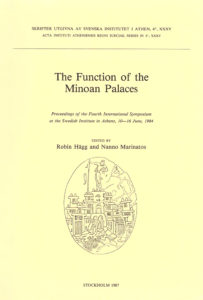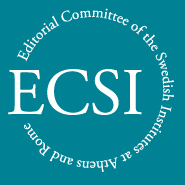 View record at WorldCat.
View record at WorldCat.
The function of the Minoan palaces. Proceedings of the Fourth International Symposium at the Swedish Institute in Athens, 10–16 June, 1984
Edited by Robin Hägg & Nanno Marinatos
Fourty-seven papers on the functions of the palace, the most characteristic phenomenon of the Minoan Bronze Age civilization in Crete, read at an international conference in Athens; the papers are followed by transcripts of the discussion of the symposium. The papers are arranged in eight groups, discussing (1) background (Near Eastern and Egyptian economy), parallels (Mycenaean palaces) and methodology; (2) the emergence of the Cretan palaces; (3) the relations of the palace with town and territory; (4) recent archaeological finds; (5) the palaces as ceremonial and religious centres; (6) the palaces as centres of trade and manufacture; (7) the administrative systems of the Minoans and Mycenaeans; and (8) the function of the frescoes in the palace.
For James Walter Graham and to the memory of Spyridon Marinatos.
Contents
Preface (p. 9)
Background and methodology
Benjamin R. Foster | The Late Bronze Age palace economy: A view from the East (pp. 11–16)
Wolfgang Helck | The dissolution of the palace economy in the Ramesside period (pp. 17–19)
Klaus Kilian | Zur Funktion der mykenischen Residenzen auf dem Griechischen Festland (pp. 21–38)
Margareta Lindgren | The function of the Minoan palaces—Myth and reality (pp. 39–42)
Antonis A. Zois | The function of the Minoan palace: A contribution to the definition of the main problem or a model for future research (outline) (pp. 43–44)
General discussion (pp. 45–46)
The emergence of the Cretan palaces
P.M. Warren | The genesis of the Minoan palace (pp. 47–56)
Stefan Hiller | Palast und Tempel im Alten Orient und im minoischen Kreta (pp. 57–64)
L. Vance Watrous | The role of the Near East in the rise of the Cretan palaces (pp. 65–70)
Gerald Cadogan | What happened at the Old Palace of Knossos? (pp. 71–73)
General discussion (pp. 73–74)
The relations of the palace with town and territory
Jean-Claude Poursat | Town and palace at Malia in the protopalatial period (summary) (pp. 75–76)
Stella Chryssoulaki & Lefteris Platon | Relations between the town and palace of Zakros (pp. 77–84)
Henri van Effenterre | The function of monumentality in the Minoan palaces (pp. 85–87)
Alan Peatfield | Palace and peak: The political and religious relationship between palaces and peak sanctuaries (pp. 89–93)
Lucia Nixon | Neo-palatial outlying settlements and the function of the Minoan palaces (pp. 95–98)
General discussion (pp. 98–99)
News from the field
Joseph W. Shaw | A “palatial” stoa at Kommos (pp. 101–110)
Yannis Tzedakis & Stella Chrysoulaki | Neopalatial architectural elements in the area of Chania (pp. 111–115)
Yannis Tzedakis & Erik Hallager | A clay-sealing from the Greek-Swedish excavations at Khania (pp. 117–120)
Hermann Kienast | Neue Forschungen im Kopais-Becken (Zusammenfassung) (pp. 121–122)
Palaces as ceremonial and religious centres
Geraldine C. Gesell | The Minoan palace and public cult (pp. 123–128)
Robin Hägg | On the reconstruction of the west façade of the palace at Knossos (pp. 129–134)
Nanno Marinatos | Public festivals in the west courts of the palaces (pp. 135–143)
Christos Boulotis | Nochmals zum Prozessionsfresko von Knossos: Palast und Darbringung von Prestige-Objekten (pp. 145–156)
Ellen N. Davis | The Knossos miniature frescoes and the function of the central courts (pp. 157–161)
Wolf-Dietrich Niemeier | On the function of the “Throne Room” in the palace at Knossos (pp. 163–168)
Erik Hallager | A “Harvest Festival Room” in the Minoan palaces? An architectural study of the Pillar Crypt Area at Knossos (pp. 169–177)
D.J. Ian Begg | Continuity in the West Wing at Knossos (pp. 179–184)
General discussion (pp. 184–186)
AnnCharlotte Nordfeldt | Residential quarters and lustral basins (pp. 187–194)
Clairy Palyvou | Circulatory patterns in Minoan architecture (pp. 195–203)
Sinclair Hood | Mason’s marks in the palaces (pp. 205–212)
Immo Beyer | Der Palasttempel von Phaistos (pp. 213–225)
Gösta Säflund | The agoge of the Minoan youth as reflected by palatial iconography (227–233)
Jennifer Moody | The Minoan palace as a prestige artifact (pp. 235–241)
General discussion (pp. 242–244)
The Palaces as centres of trade and manufacture
Keith Brannigan | The economic role of the first palaces (pp. 245–249)
Stylianos Axeliou | Minoan palaces as centres of trade and manufacture (pp. 251–253)
Günter Kopcke | The Cretan palaces and trade (pp. 255–260)
Malcolm H. Wiener | Trade and rule in palatial Crete (pp. 261–267)
General discussion (pp. 267–268)
Olivier Pelon | Minoan palaces and workshops: New data from Malia (pp. 269–272)
J.A. MacGillivray | Pottery workshops and the old palaces in Crete (pp. 273–279)
Gisela Walberg | Palatial and provincial workshops in the Middle Minoan period (pp. 281–285)
Karen Polinger Foster | Reconstructing Minoan palatial faience workshops (pp. 287–292)
Colin Macdonald | A Knossian weapon workshop in Late Minoan II and IIIA (pp. 293–295)
Mervyn Popham | The use of the palace at Knossos at the time of its destruction, c. 1400 B.C. (pp. 297–299)
General discussion (pp. 299–300)
From Minoan to Mycenaean administration
Thomas G. Palaima | Preliminary comparative textual evidence for palatial control of economic activity in Minoan and Mycenaean Crete (pp. 301–306)
John Bennet | Knossos and LM III Crete: A post-palatial palace? (pp. 307–312)
J.T. Hooker | Minoan and Mycenaean administration: A comparison of the Knossos and Pylos archives (pp. 313–316)
Paul Åström & Karl-Erik Sjöquist | The scribes and their helpers in the palace at Pylos (pp. 317–319)
General discussion (pp. 319–320)
The function of frescoes in the palaces
M.A.S. Cameron | The “palatial” thematic system in the Knossos murals. Last notes on Knossos frescoes (pp. 320–328)
Final discussion (pp. 329–333)
Programme and participants of the symposium (pp. 335–336)
Abbreviations (pp. 337–339)
Index (pp. 341–344)
Index of maps and plans in the text (p. 344)
Bibliographical information
Robin Hägg & Nanno Marinatos, eds., The function of the Minoan palaces. Proceedings of the Fourth International Symposium at the Swedish Institute in Athens, 10–16 June, 1984 (Skrifter utgivna av Svenska Institutet i Athen, 4°, 35), Stockholm 1987. ISSN: 0586-0539. ISBN: 978-91-85086-94-8. Softcover: 344 pages.
Reviews
The Classical Review 39:2, 1989, 335–338 (Christiane Sourvinou-Inwood) https://doi.org/10.1017/S0009840X00272090
Revista de História 121, 1989 (Norberto Luiz Guarinello) https://doi.org/10.11606/issn.2316-9141.v0i121p141-147

No Comments
Comments are closed.